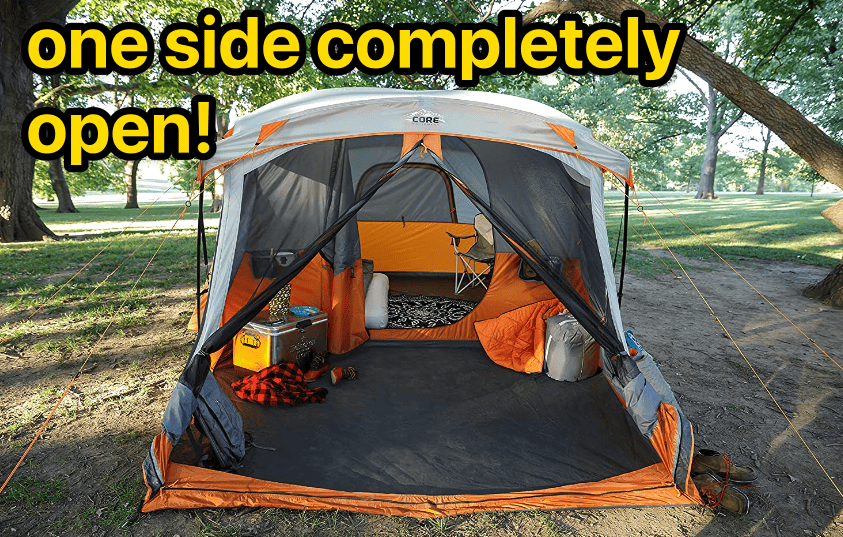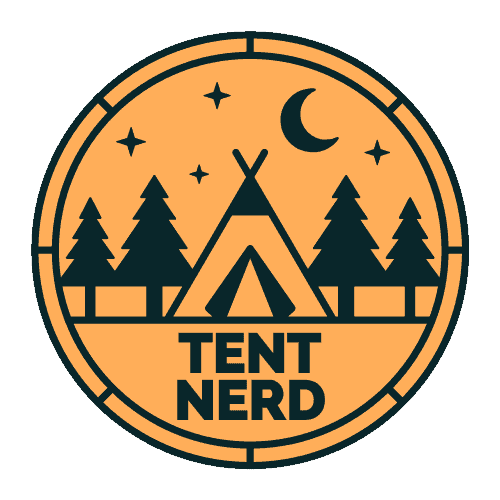SUMMARY: For those dealing with claustrophobia, the top choice is a tent with ample space, good ventilation, and transparent or light color materials – providing a sense of openness. Specific models championing these features include tents like the Big Agnes Copper Spur HV UL3, MSR Hubba Hubba NX 2, and the Coleman Cabin Tent with Instant Setup.
Ever felt like a canned sardine in your tiny tent during a camping trip? 🏕️
Bet you wish you could “Alakazam!” yourself out of there, huh? 😅
Here’s a sneak peek into what we’ll be delving into:
- The magical charm of spacious nests: The 8-person and 10-person tents 🎪
- Doors and windows in a tent; not just an architectural decision, largely a breath of fresh air, literally! 💨
- Unveiling the magic of open-sided tents ⛺
- It’s a tent, not a fortune cookie! Discussing cost vs comfort for our claustrophobic champions out there 💸
So belt up, let’s make your next camping escapade a spacious and breezy reality! 🚀
The Size Matters: Choosing the Bigger Tent

Ever tried to fit into a pair of jeans one size too small? Exactly. 👖
That’s how you feel in a tiny tent with claustrophobia as your uninvited guest.
Here’s where your secret weapon comes in – 8-person or 10-person tents. No, we’re not subtly hinting at starting your own camping community. Let’s look at why these bigger tents are your knight in shining fabric:
- Space Galore: These larger tents give you room to roam, stretch, and maybe even practice some morning yoga. 🧘♀️
- Claustrophobia’s Nightmare: Coffin-sized tents? They are claustrophobia’s playground. Spacious tents, on the other hand, are claustrophobia’s worst nightmare. All that air and openness? Bliss. Pure bliss. 🏞️
- Storage Heaven: In case you are wondering, you also get extra room for your camping knick-knacks!
Remember, size does matter when it comes to tents. A tiny tent might be lighter on the back and the pocket, but an 8-person or 10-person tent? That’s lighter on the mind. 😊
This is the more spacious version of what I own 👇
The Significance of Windows and Doors
Contrary to what might initially be assumed, the role of windows and doors in a tent goes beyond providing paths for entry and exit. They play a massive role in creating a sense of space and non-confinement that can offer great comfort to those combating claustrophobia. Here are a few reasons that highlight their importance:
An Illusion of More Space
- Windows and doors can break the monotony of an enclosed space, providing visual outlets that create the illusion of a larger, more airy space. Having multiple windows not only invites plenty of light into the tent, but it also allows you the comfort of seeing what’s happening outside; a feature that can be especially reassuring for anyone dealing with claustrophobia.
Multiple Exits: For a Sense of Freedom and Safety
- The prospect of having multiple exits can significantly reduce the anxiety that someone with claustrophobia might feel. Knowing that there are several ways to leave the tent provides a comforting sense of freedom. It offers an extra layer of psychological safety, enabling a more composed and relaxed camping experience.
Practical Advantages
- Apart from the psychological comfort, multiple exits can also be practically beneficial. For instance, they make it easier for multiple inhabitants to enter or exit the tent without disturbing each other. On a breezy day, they can also create an effective cross-ventilation system within the tent, making your camping experience even more enjoyable.
In summary, while choosing a tent with ample windows and doors might seem like a minor detail, its impact on alleviating claustrophobia is huge. So when it comes to selecting a camping tent, don’t underestimate the value of multiple doors and windows!
Exploring Tents with Open Siding

For individuals with claustrophobia, choosing a tent with open siding can indeed be a game-changer for enhancing their outdoors experience. These types of tents are specifically designed to provide a free-flowing, expansive atmosphere, which plays a significant role in alleviating the feelings of anxiety and confinement often associated with claustrophobia. Here’s why it’s an excellent option:
Provision of a Non-Confining Environment
- Traditional tent designs, while useful and practical, are enclosed. This structure can bring discomfort to those coping with claustrophobia. In contrast, tents with open siding provide a non-restrictive environment that evokes a sense of openness and freedom.
Blend of Indoor Comfort and Outdoor Exhilaration
- Tents designed with open sides allow you to enjoy the comfort of a shelter while still being able to connect with the wonders of nature. It’s a unique blend that offers indoor security and outdoor exhilaration, significantly contributing to a stress-free camping experience for those grappling with claustrophobia.
Direct Contact with Nature
- Open-sided tents offer the camping purists the direct contact with nature they often crave. In these tents, you’re not just peering out of a small window but are quite literally living in the lap of nature. You can see, hear, and feel nature, all while inside the comfort of your tent. This direct contact with nature can bring relief and satisfaction to a claustrophobic individual.
Given the various benefits provided by open-sided tents – the absence of confinement, a perfect blend of comfort and connection with nature, and the freeing feeling it provides, it’s easy to see why they’re a highly recommended option for those dealing with claustrophobia. Sure, there may be a few drawbacks – such as less protection against weather and insects – but the overall enhancements to the camping experience make it an option worth considering.
Balance is Key: Price vs Comfort
Camping, particularly for individuals dealing with claustrophobia, is so much more than a simple bonding with nature. It’s a trip that requires careful planning and appropriate resources. While budget-consciousness is important, it’s equally crucial to prioritize the level of comfort a tent can offer, and sometimes, that means paying a bit more. Here’s why:
The Investment in Comfort
- Yes, larger tents with additional features like multiple doors and windows or tents with open siding tend to be costlier than their confined counterparts. But would it really be a price too steep if it guarantees you a better camping experience? The extra space, airy feeling, easier exits, and an overall more comfortable environment are all benefits that can significantly enhance the quality of your camping trips, all while alleviating claustrophobia-related anxiety.
Long-term Savings
- Investing in a pricier yet more comfortable tent can actually save you money in the long run. How so? When you purchase a cheap tent that does nothing to mitigate your claustrophobic tendencies, you may eventually find yourself needing to upgrade. Instead, if you spend a bit more up front on a tent providing the appropriate comfort, you won’t feel the need to replace it as quickly or frequently.
Camping Enjoyment
- Let’s not forget the primary reason why we camp – for enjoyment. The whole point of camping gets defeated if any part of the experience causes you anxiety or distress. Hence, paying a bit more to provide yourself with the best possible experience is arguably, a no-brainer.
All in all, while keeping budget considerations in mind, it’s equally, if not more, important to focus on the comfort and overall experience the tent will offer. After all, a camping trip should be an escape to tranquility, not a trial of endurance. So, opt for a balance between price and comfort to really make the most out of your outdoor adventure.
Takeaways
Choosing the right tent can truly elevate your camping experience, more so when you’re battling claustrophobia. The perfect tent can act as the sanctuary you need, offering a comforting getaway without limiting your sense of space.
- For the claustrophobic camper, an 8- or 10-person tent is highly recommended even for solo trips. The spacious interior, far from being wasteful, allows for freedom of movement and brings in a refreshing airiness that can alleviate the fear of enclosed spaces.
- Your tent’s layout can make a significant difference. Multiple doors and windows facilitate an easy exit route while also inviting sunlight inside. This feature can dramatically reduce feelings of being trapped, making for a more enjoyable camping experience.
- Tents with open siding offer an almost outdoors-like experience while still being shielded from the elements. This unique design allows you to soak in your surroundings without the constraint of tent walls.
- While one might need to slightly stretch their budget, it’s absolutely worth prioritizing comfort over cost. The peaceful night’s sleep and the sense of well-being provided by a suitable tent far outweighs the extra expenditure.
Remember, the best tent for claustrophobia is the one where you can relax and enjoy the beauty of nature without being overwhelmed by your fears.
Tent FAQs
What size of the tent should I choose if I am claustrophobic?
We recommend opting for an 8- or 10-person tent. The large interior expanse reduces feelings of confinement and offers a sense of spaciousness.
What type of tent is suitable for different weather conditions?
Three-season tents offer a balance of ventilation and warmth retention, making them suitable for spring, summer, and fall. For harsher winter conditions, a four-season tent would be more appropriate. However, ensure these carry the claustrophobia-friendly features mentioned.
How many windows should a tent have to be optimal for a person with claustrophobia?
There’s no hard and fast rule, but more is generally better. Multiple windows increase light inside the tent and offer various views of the outside, helping to ease feelings of confinement.
Are there specific brands that manufacture tents suitable for claustrophobic campers?
There isn’t an exclusive line of tents for claustrophobic individuals. However, many brands produce larger tents with multiple doors, windows, and open siding. Look into established outdoor brands for quality options.
How much more should I budget for a claustrophobia-friendly tent?
While tents that cater to claustrophobic needs may cost a bit more than a standard 1- or 2-person tent, consider this an investment in your comfort. The price can vary greatly based on the brand and specific features. Always compare tents that offer the space and features you need before finalizing your purchase.

